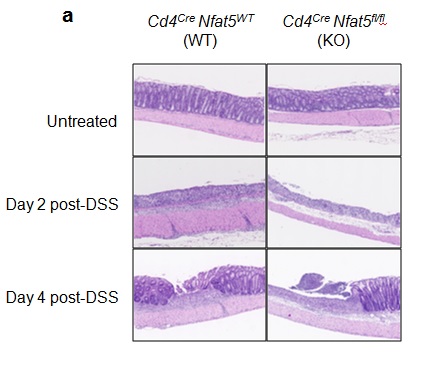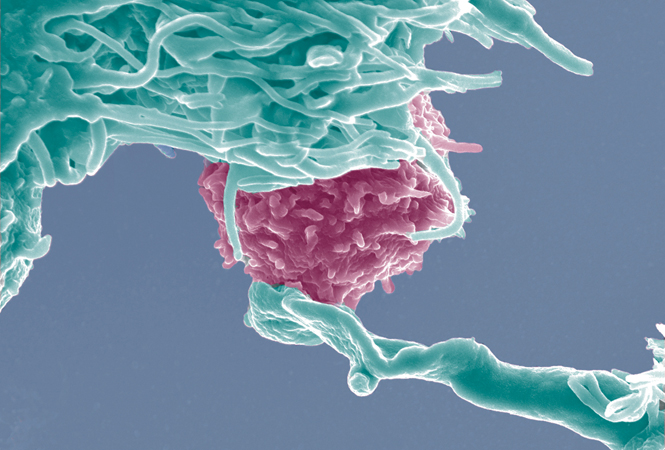The NFAT5 protein, a possible protector against immunological disorders
Scientists at the Department of Experimental and Health Sciences at UPF (DCEXS) have discovered new functions of the NFAT5 protein in immune defence, as a regulator of the intensity of inflammatory processes mediated by T-lymphocytes.
For some years, NFAT5 has been known for its role in the activation of cellular defence mechanisms at situations of hyperosmotic stress, that is, when tissue salt concentration increases. This study, published in the journal Immunology & Cell Biology, reveals that NFAT5 can also reduce pathogenic inflammatory responses in T cells regardless of their stress response function. The work, led by Jose Aramburu and Cristina López-Rodríguez, heads of the NFAT Proteins and Immune Response research group has been developed by DCEXS doctoral students in Biomedicine Maria Alberdi and Sonia Tejedor in collaboration with the group of Ramón Merino (University of Cantabria).
NFAT5 is fundamental for the adaptation of mammalian cells in highly saline situations, such as those found inside the kidney. Despite belonging to the same family of proteins as NFATc and NF-kB, well known for their key role in immune functions, the function of NFAT5 factors in the immune system had remained far less known. Studies with NFAT5-deficient mouse models previously developed by López-Rodríguez (www.ncbi.nlm.nih.gov/pubmed/22312110 and www.ncbi.nlm.nih.gov/pubmed/24043824) have discovered that, in addition to its osmoprotective function, NFAT5 regulates embryonic development and not only influences various immune functions in situations of saline stress, but also controls the threshold of response to pathogens and the development of T-lymphocytes.

T-lymphocytes are a major cell type responsible for maintaining the balance between the body's ability to fight infections and tumours while avoiding excessive responses that lead to autoimmune disorders. The current work published in Immunology & Cell Biology shows how NFAT5 can trigger different types of genes in T cells depending on the context of stress or the presence of inflammatory stimuli and tissue damage, and therefore confers elasticity to the immune system to allow steering the type of lymphocyte response in different directions.
The involvement of NFAT5 in immunological disease in humans is currently unknown. However, a recent study conducted by John Chang’s group at the University of San Diego California, in which López-Rodríguez and Aramburu collaborated, identified the first human patient with a partial deficiency in NFAT5. This patient was diagnosed with various immunological disorders, some of them similar to the pathology observed in the NFAT5-deficient mouse model described in the work. The research conducted by researchers from UPF, which identifies the ability of NFAT5 to modulate the intensity of immune responses and to distinguish stress from other inflammatory contexts, illustrates how the immune system is able to perceive and accurately integrate multiple sources information to maintain the functioning of the organism before a wide variety of environmental disturbances.
Reference work: Maria Alberdi, Marcos Iglesias, Sonia Tejedor, Ramón Merino, Cristina López-Rodríguez and Jose Aramburu. Context-dependent regulation of Th17-associated genes and IFNγ expression by the transcription factor NFAT5. Immunology and Cell Biology. September 2016; doi: 10.1038/icb.2016.69
Previous studies:
Buxadé M, Lunazzi G, Minguillón J, Iborra S, Berga-Bolaños R, Del Val M, Aramburu J, López-Rodríguez C. Gene expression induced by Toll-like receptors in macrophages requires the transcription factor NFAT5. J Exp Med. 2012 Feb 13;209(2):379-93. doi: 10.1084/jem.20111569
Berga-Bolaños R, Alberdi M, Buxadé M, Aramburu J, López-Rodríguez C. NFAT5 induction by the pre-T-cell receptor serves as a selective survival signal in T-lymphocyte development. Proc Natl Acad Sci U S A. 2013 Oct 1;110(40):16091-6. doi: 10.1073/pnas.1215934110

